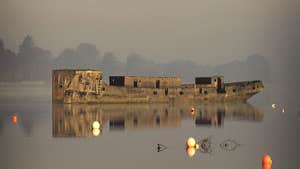Over the years, several theories have advanced about the origins and uses of the Creteboom, Some say it was built as a decoy to fool the bomber-crews of the German airforce. Others say it was used to train naval cadets in WW1, or employed to bring ammunition from England to France during the same period. None of these stories are true but the history of this old maritime relic is fascinating nonetheless.
In 1917, three years into WWI, Germany was showing no signs of ceasing hostilities, and at the same time, Britain was experiencing a severe steel shortage. A fleet of ships was needed to transport iron-ore from Spain to Britain, but building the fleet would further deplete steel supplies. An alternative method of building was the answer and it was decided that a concrete fleet would be viable.
Unforeseen snags with budgets and a shortage of craftsmen prevented the building programme from being completed and after the war ended in 1918, work was cancelled with only those vessels near to completion being finished. 52 barges and twelve tugboats were completed, the last of the vessels being launched in 1920. Ironically, none were built in time for active service.
In 1922, a company of London based ship-owners, Stelp & Leighton, Ltd., bought the surviving tugboats and concrete barges (including the Crete Boom) and set up the Crete Shipping Co in Sunderland. All vessels were used to tow coal to the Continent until the business ceased operations in 1924, leaving the vessels mothballed on the Tyne.
The Crete Boom then spent time in the icy waters of the Baltic. When the Crete shipping Company failed in 1924, the Creteboom was laid up on the River Ware before being sold to the South Stockton Shipbreaking Co. On April 27th 1935 it was dismantled and stripped of its metal parts until all that remained was the concrete hulk.
In 1937 the Creteboom, together with several other old wrecks, was boughtby the Ballina Harbour Commissioners to sink them at the entrance to the river Moy where they would form a sand barrier. During the move from England, the vessel sustained damage and started taking on water. The Ballina Fire Brigade pumped the vessel but were not capable of stemming the flow. To avoid it sinking, the Harbourmaster, Mr Eddie Melvin, ordered it to be removed from the jetty fearing it would block the quay. It was towed to mid-stream where it settled on the bottom and remained for forty years.
The sand barrier idea was postponed when the Moy Fishery Company threatened legal action, fearing a possible interference with the run of salmon into the River. That and the outbreak of World War II in 1939 led to the abandonment of the project. The ship was cleaned and refloated in 1974 to its current location.
The Creteboom had a short useful life but never fulfilled its original purpose. Today, its mysterious, brooding hulk forms an eye-catching focal point at Ballina Quay and Belleek Woods, an iconic part of Ballina’s infrastructure.
